How to Stop Your Dog from Eating Everything on the Ground
- Anja Boecker
- Updated: 2023-06-07
We hear toxic bait warnings all the time, often for popular dog walking routes, but often on ordinary streets as well. Animal haters are always targeting our beloved dogs.
It is hard to imagine the suffering they cause to owners, dogs and even wild animals. How can you protect your dog from such venomous attacks? The best way, of course, is with anti-poison baiting training!
With that in mind, here's a guide to putting a stop to your pet's habit of picking things up without your permission.
If you've been wondering how to stop my dog from eating everything he sees, worry no more: here are 5 steps to prevent food poisoning!
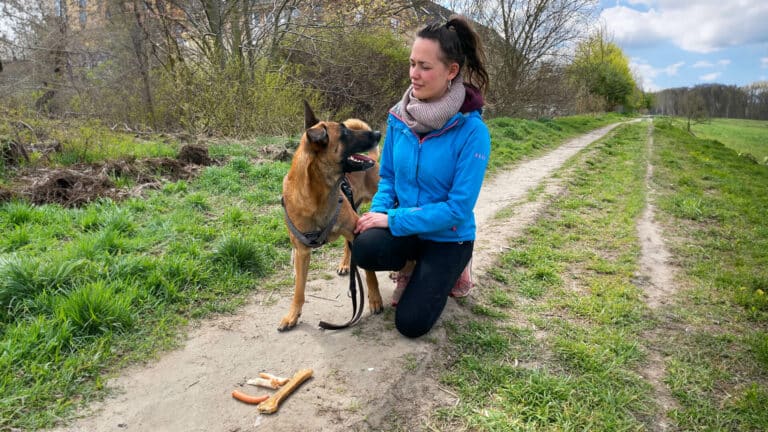
What Is the Training to Keep My Dog From Eating Everything on the Ground?
Stop My Dog from Eating Everything on the Ground training is designed to prevent dogs from ingesting unknown or potentially dangerous substances that they may find on a walk or in their environment.
This can be especially important in areas where people are known to intentionally place poisoned bait. However, it is also a useful skill for any dog in general to reduce the likelihood of poisoning.
A typical training session to stop my dog from eating everything he sees might include the following elements:
- Command “Leave It”: This is where the dog is taught to release or drop something it currently has in its mouth on command.
- Do Not Record Command: The purpose of this command is to prevent the dog from picking up or eating anything before it has put it in its mouth.
- Impulse Control: The dog should learn to control itself and wait for permission before eating or picking up anything.
- Proper Leash Training: Keeping a dog on a leash and close to its owner can help prevent it from coming into contact with hazardous materials.
- Positive Training: It is important to keep training positive to avoid stress or anxiety. Rewards such as treats, praise, and toys can help reinforce desired behavior.
As with any training, consistency and patience are important. Some dogs learn these skills more quickly than others. Always keep your dog's safety and well-being in mind.
If necessary, a professional dog trainer may be helpful.
Toxic Bait Found - What Do I Do?
- Documentation of the Find
It's best to take a picture of where you found the bait and the bait itself, maybe even a video. - Pick up Bait Carefully
There may be broken glass, razor blades, or nails in the bait, so be careful! You can use a poop bag to pick up the bait. - Search Surroundings
A toxic bait is rarely alone, usually several are placed in an area. - Go to the Police
Be sure to report the find to the police. If poison is suspected, you can also take the bait to a veterinarian to determine the poison. That way, possible victims can be helped more quickly. - Report Found
You can also post your find on Poison Bait Radar or Poison Bait Alert to warn other dog owners. There may also be local Facebook groups where you can report the find. It is also helpful to make warning signs and post them near where the dog was found.
Places Where Toxic Baits Are Often Placed
The most common targets are high-traffic dog walking areas. Off-leash areas are also popular targets. But beware, public places are not the only targets of dog haters:
Private property is also used. Many a neighborhood dispute ends with a poisoned bait flying over the fence. Some dog haters also place poisoned bait at the edge of their property for passing dogs to pick up.
Farmers are constantly suffering from dog feces in their fields, poisoning their cows, and unfortunately sometimes resort to such cruel and unforgivable measures.
Playgrounds are also often targeted, which can have very serious consequences for young children. Various parks are also popular targets. Wild animals like hedgehogs and martens also suffer from this blind hatred.
Why Is Training to Stop My Dog From Eating Everything on the Ground So Important?
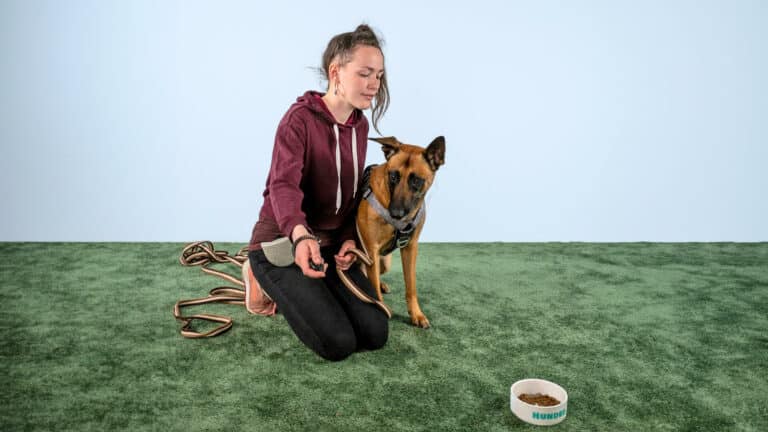
The main reason is obvious: The dog should not eat poison bait!
Of course, you can protect your pet from poisoned bait with a special muzzle. But this restricts the dog's freedom. Some very greedy dogs will always manage to grab something from the ground, even with poison bait protection.
Also, reports of poison bait in metropolitan areas tend to come in a big wave, so any poison bait protective muzzles sell out quickly locally. They can be ordered online, but most have longer delivery times due to high demand.
For many dogs and owners, this is simply not a permanent solution.
It is not only poisoned bait that should worry dog owners. Especially in cities or along busy roads, you can often find food scraps that people carelessly throw away.
Chocolate, heavily spiced kebabs or even vomit attract many dogs like the scent of a fresh rose attracts a bee. The difference is that these foods are absolutely toxic to many dogs and can result in an (expensive) visit to the vet.
Therefore, not only puppies should learn early not to eat from the floor without permission. Older dogs that have changed owners or come from the shelter should also learn this.
With the latter, it's a little more difficult, especially with former street dogs who fed mainly on what they found on the street. But time (and training) can fix almost anything.
Has your dog eaten something outside? Watch for symptoms.
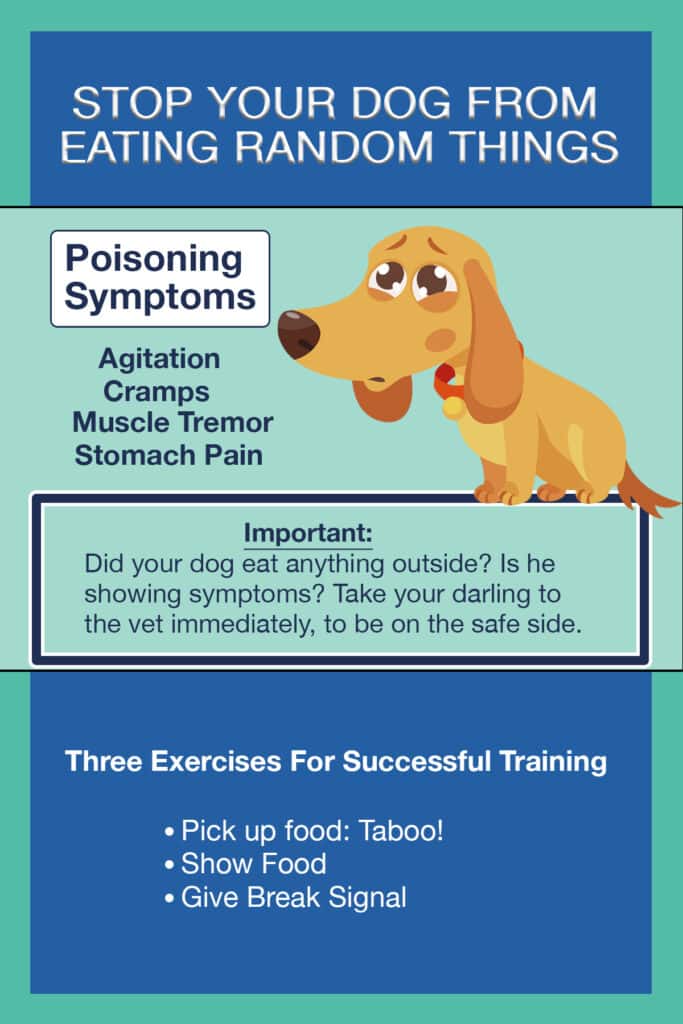
A Guide to Stop My Dog From Eating Everything on the Ground
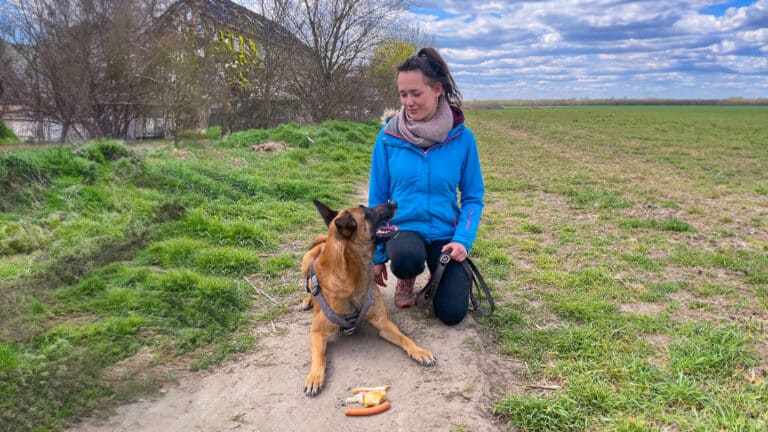
1) Clarify What’s Edible & What’s Not
In general, you can prohibit your dog from eating things off the ground outside. However, if you are interested in playing outdoor games with your dog that involve food, such as hunting or retrieving, you should teach your dog that he can only pick up things from the ground with your permission (see point 6 for more information). Otherwise, misunderstandings can occur. Your dog won't understand why the treat you throw him is okay to eat, but the cheese sandwich on the corner of the house is not. Search and rescue games make sense for very active or highly motivated dogs. It is a great way to keep them mentally busy outside or even distract them from a game sighting.
2) Prepare the Right Bait
The training begins like this: First, you put the food out on the sidewalk yourself, preferably on a cardboard tray that you can easily dispose of afterwards. That way, there will be no leftovers on the street. Your "bait" should be something tasty, but not too tasty. Otherwise, your dog will not be able to control himself and the training will not be successful. Mastery must be learned first! So start with something simple, like a piece of sausage. Then you can slowly work your way up to liverwurst, ham, bacon, cheese, ground beef, or boiled chicken. These are also the foods most often used as a base for poison bait. At the same time, you should have a treat available, such as a dog liver sausage in a tube. It should be something your dog loves and rarely gets. Smelly, moist treats also work well. Some people use the same thing as bait as a reward, which can also work well. However, it is not healthy in large quantities. You can also alternate your bait material with dog liver sausage, so you can combine both variations and your dog will love the toxic bait training!
3) The Training Method
Now place your first lure so that you have to walk past it. If the lure is on the left side of the path, take your dog to your right. Take enough distance, so much that your dog doesn't notice anything of the lure. It's best to have a second person help you place your fake lure correctly here. Now it goes "to the sausage". Take your dog close to your side, tie the leash to the collar, and walk toward the lure. Your dog should approach the lure head on, in a straight line. As soon as he notices the lure and registers his treat, you should step in and push the dog to the side with your foot facing him, jerking but with feeling. Here you can include a word like "leave it" or even a simple "no." Feel free to say the word with a stern determination, dogs understand clear communication better. But be friendly again afterwards and praise your dog a little if he made it past well. Repeat this several times until your dog makes a turn around the lure on his own the first time. Here you praise generously and give him a reward. If you notice it's getting to be too much for your dog, include a reward in between for getting him to make a bow. This will keep him more motivated and more likely to learn. Important: Keep moving and don't stop. Really walk past the lure and show your dog that the food on the ground has nothing to do with him.
4) Rinse & Repeat
You can increase the training as much as you like. Start with one paper plate of sausage, then add several paper plates of treats and increase the difficulty. Also, change the training location so your dog understands that the food ban is not just in one place. Once your dog has really developed good control, you can also place the food on plastic wrap on the floor for the ultimate test. This way, there is no white paper plate or the like marking the off-limits area. Important: If you find incentives on your normal walk, such as a banana peel on the ground or half a sausage roll, use them to practice! Do the exercise and walk past the object several times. Keep going back and forth until the dog makes the turn around the stimulus on his own. Build this exercise into your long walks and eventually there will be nothing left for your dog to pick up. At the same time, you'll be practicing anti-poison bait training on a regular basis, and you'll always be on the safe side.
5) Stay Consistent
Some dogs acquire such infinite discipline and you can teach them to just sit in front of the food find and wait. Still, you should go through the program with the lures beforehand so that the dog really knows not to eat it. It's not the same as him waiting at home in front of his food bowl for your release. After all, outside he is not allowed to eat the food on the ground. If you have practiced carefully and your dog makes the bow automatically, you can give him a sit command at some point in the moment when he wants to strike the bow. Then you put the lure away. Pack it up or throw it in a trash can. In any case, your dog should understand that he will not get what was lying there. And he should not get the training food from the floor either, not even after training or for dinner!
You can find more exercises in our app: Train your dog through the Dog Encounter course with step-by-step video instructions.
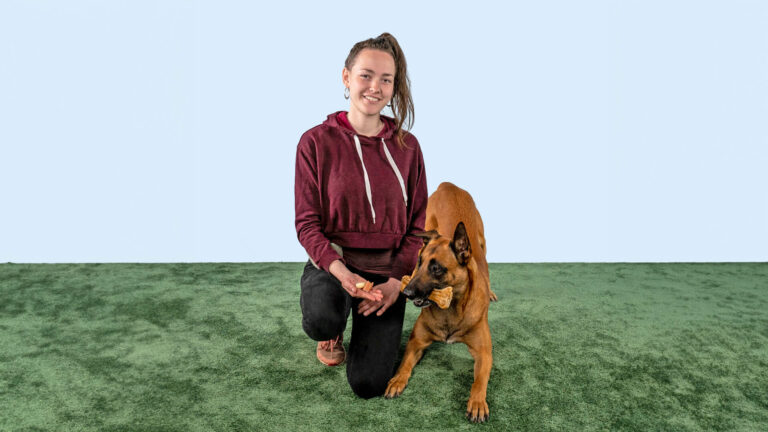
Search and Hunt Games After Training
In some games, it is important for your dog to sit and wait for you to put the food down. This teaches him from the start that he can't just run off. Place the food only where you are sure there is nothing else (check the spots beforehand).
Let your dog search only on command, never on its own without your permission. You can practice this by placing treats near places where your dog is not allowed to search because he does not have a search command from you.
With hunting dogs with a strong hunting instinct, it becomes more difficult.
At the beginning of training, for example, to get a better handle on the hunting instinct, it may be helpful to throw a very tasty treat. The dog is allowed to eat it from the ground without letting go.
Because one of the attractions of hunting is to run and chase whatever is moving (in this case, the treat). This distracts the dog from the actual prey (the animal he saw).
In the long run, however, it is advisable to work more on impulse control. Independent chasing of fast moving objects should be discouraged. However, it can be allowed on command.
Example: The ball flies, the dog must wait in the seat until the ball has landed and is still on the ground. Then the dog must give way, give a paw, give a command.
The dog must then look the handler in the eye. Only then does the handler give the command for the dog to retrieve the ball. In this way, the dog learns that you don't just run headlong after things that are moving fast.
Frequently Asked Questions
No problem! Nobody is perfect. Next time you need to be quicker and pull your dog away from the lure in time to turn the bow.
Usually 3 times a week for 10-20 minutes is enough, depending on your dog's condition and performance. Training should always be fun for your dog. It should be a pleasure for him to participate and not a pain. Breaks from training are also important for the dog so that he can properly process what he has learned.
You really should throw away the food on the plates. A tip: Take only a small amount, leave most of it in the fridge and prepare something tasty. The portion should be large enough for your dog to notice the bait and find it attractive. This threshold is quickly reached by greedy dogs, even with small amounts, no matter how big the dog is.
It is a good idea to divide your dog's food into several portions, especially if he is a glutton. For example, before the first walk, you can give him ⅓ or ½ of his daily ration. This will reduce the urge to eat things off the ground. Your training will be more successful. For dogs with strong hunting instincts, this will also reduce the urge to chase animals. The dog has already "hunted" that day. Very active dogs will become calmer.
Conclusion
Toxic baits are terrible and cause a lot of suffering. Basically, the only thing you can do is protect yourself and your dog in advance with proper training.
What drives many dog haters to their atrocities is the dog excrement left around. This is not only a nuisance to non-dog owners, but also a dangerous disease vector for other dogs.
If you see someone leaving their dog's poop behind, talk to them politely about it and ask them to understand, maybe offer them a poop bag to clean up the poop immediately. Hopefully, this pile of poop will not be the straw that breaks the camel's back.
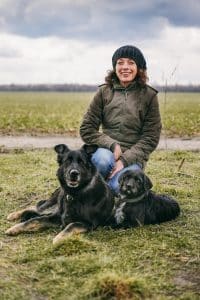
My name is Anja Boecker, and I am a certified dog trainer and behavior consultant. With these articles, I want to help you to understand your dog better and to build an inseparable bond.
Share Now:

